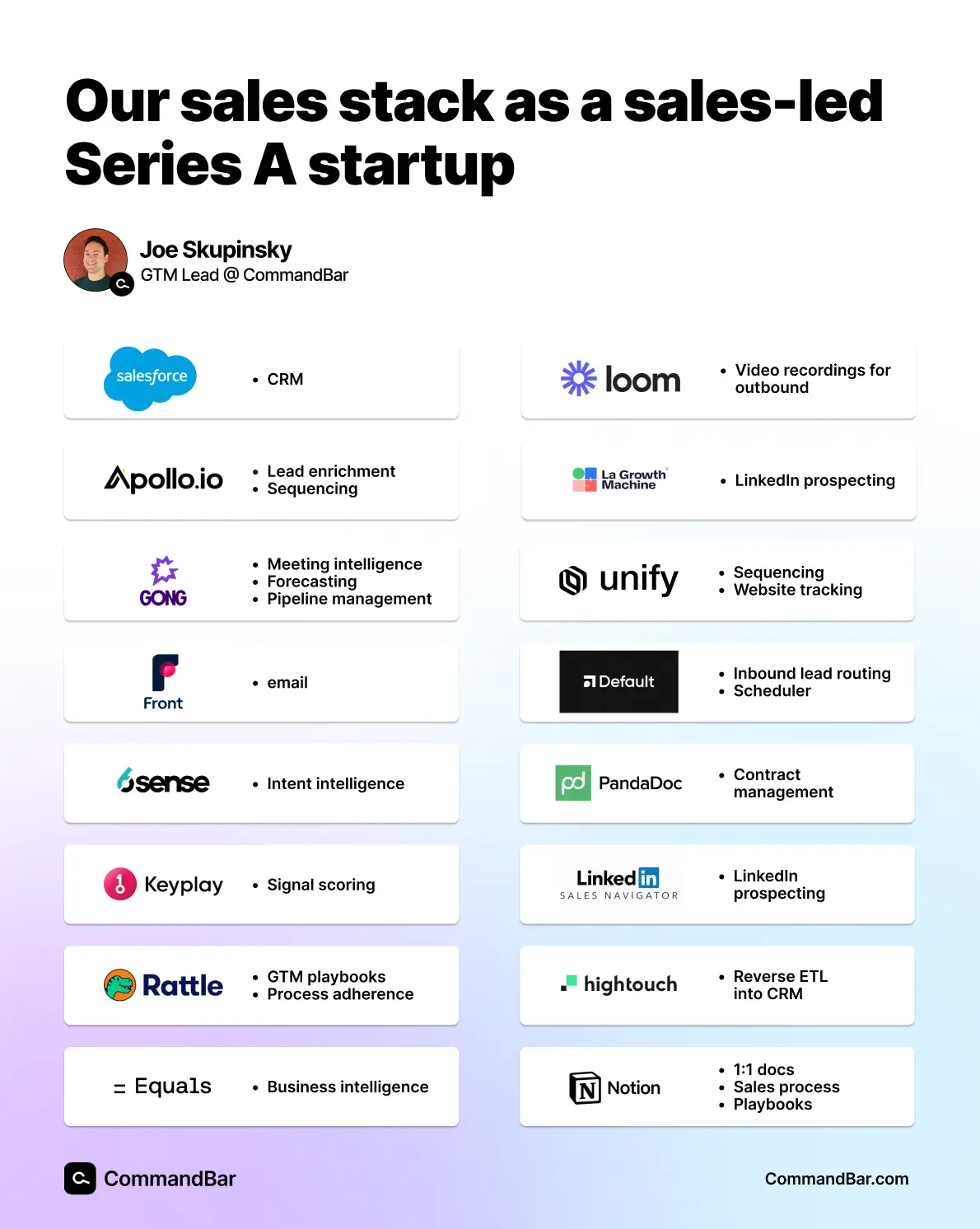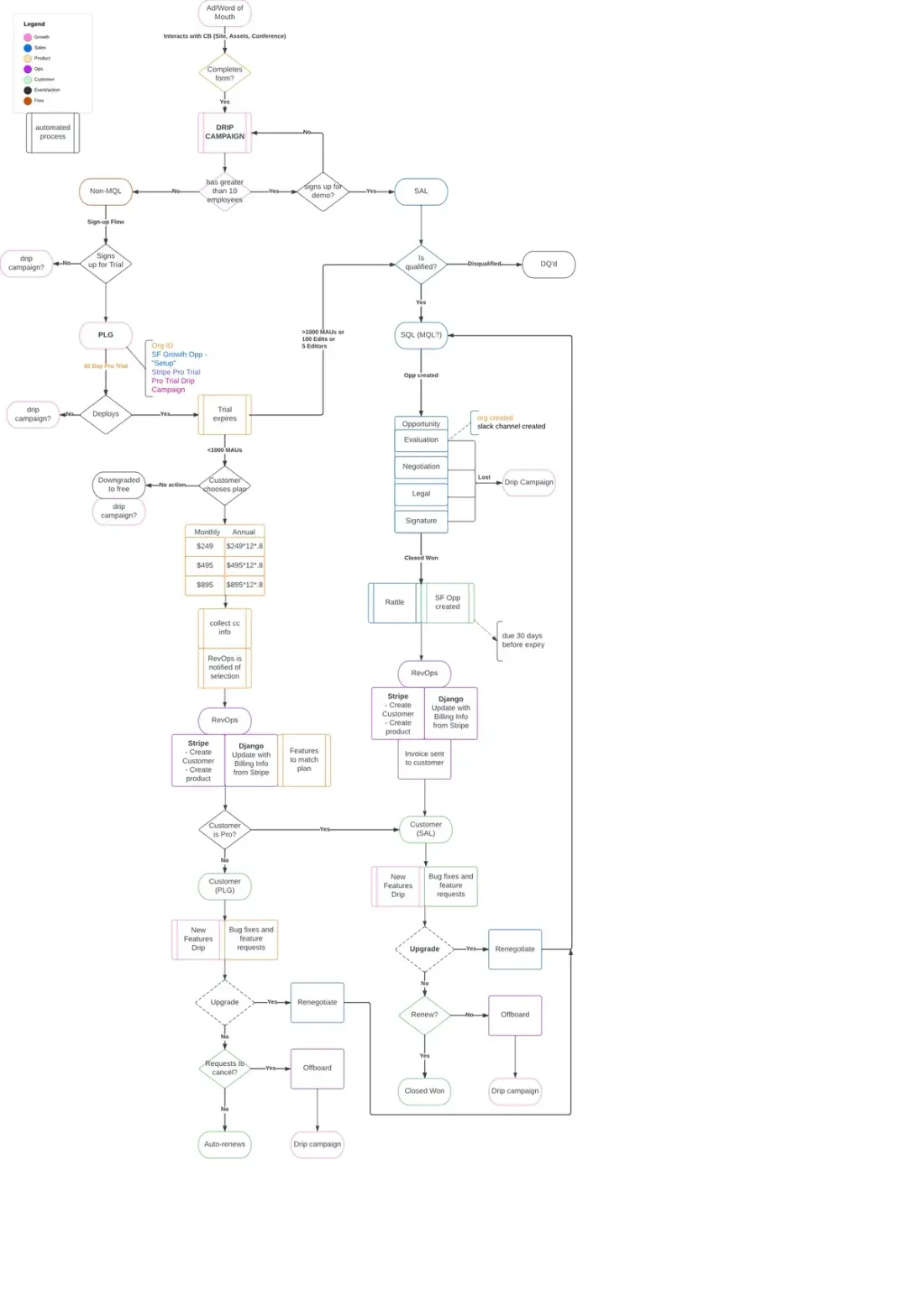How our sales team achieved 35% QoQ revenue growth (+everything we use to sell)

Going sales-led increased our deal size by 34% and conversion by 17%. in this article, you’ll find out how we did it. I chatted with our GTM leader Joe Skupinsky about how we approach sales and the software we use to run a high-performing sales team.
In this article, you’ll find out exactly how we built our sales team, what tools we use and the resources we recommend for anyone in sales. Before we dive into the nitty-gritty, here’s our current sales stack:
Command AI’s sales stack
When Joe joined the team, our CEO and founder James did most of the selling for Command AI. When Joe joined, he started building the sales org.

How to build a sales org
You might think building a sales motion means jumping on calls all day until your calendar looks like a game of Tetris. While Joe did some of that, his first priority was building systems (after understanding the product and current prospects/customers).
- CRM: Doing sales well requires knowing exactly which prospects you have, what stage they’re at, etc. One of the first things Joe did was set up Salesforce so we could get that overview.
- Structuring the process: It’s important to know how you want to get new customers. Which deal stages do you need? What meetings should there be? What should your deck look like? How do you qualify leads?
In the beginning, our customer journey map looked like this:

This is a higher-level overview than individual team members use in their day-to-day. There are more discrete processes and systems for selling individual customers and for customer success operations.
But you can tell Joe loves systems, so that’s how Joe started at Command AI. And it’s not just this high-level stuff. He also designed pilots in detail—adding more guardrails instead of waiting for prospects to decide, redesigned decks, and made many other behind-the-scenes decisions.
He also told me about mistakes many sales leaders in startups make. He cited two main failure modes.
- First was not having a process. Startups are flexible, but that doesn’t mean you can just wing it. Without a reliable process you’re wasting time by starting from scratch each time. You also lack the ability to diagnose problems: If prospects constantly drop off during the trial stage, you know where to improve. Without process, you’re in the dark.
- The second failure mode was not preparing for meetings. Even if you’re not a founder, customers need to trust you. As Joe told me: “People will be averse to buying from someone who doesn’t have their shit together. People want to buy from people they feel confident about.”
These are the kinds of things you need to have when you want to build a great sales team. Team? Yes! Joe joined in March of 2022 and hired our first account executive Peter in November of 2022.
How to build a startup sales team
Peter joined the team when we had all the systems set up. These systems enabled us, as Joe told me, to “forecast almost exactly how much more revenue a new AE will bring in, how long it’ll take for them to ramp, and so on.”
A common mistake in sales leaders is to wait until their calendar is so filled with meetings that they can’t possibly take another. Instead, Joe hired as soon as the systems were set up. That’s because a sales leader needs to work on strategic things. There are always system-level things to work on, which are higher-leverage than individual calls.
Once Peter was on board and we continued to get leads, the hiring strategy became more pragmatic. Joe always asks himself: “If we got 10 more great opportunities this week, would we just drop the ball on all of them?”
The closer the answer gets to “yes”, the more urgently you need to hire.
Salespeople need to know the product
“Salespeople should almost be PMs themselves. They need to understand the product in and out.”, Joe told me.
The reason is obvious: “I’ll have to talk to the product team for that”, slows down deals and makes the salesperson look less of an expert. That’s why our, salespeople use our product the most.
Sales is also keyed into the product roadmap and what’s a priority, they can respond more accurately to feature requests (and avoid the “product hates sales” issue many run into).
But while account executives convert opportunities in the funnel, you also need to create new opportunities. That’s why we hired sales development representatives (SDRs).
When to hire SDRs
“You can never have enough pipeline” Joe told me when I asked him why he decided to hire SDRs. SDRs are outbound sales reps who aim to book meetings with prospects via LinkedIn, email, etc.
He knew it was time to bring in an SDR. His response: “It’s just pouring gas on the fire. You can always have more pipeline.”
In sales, Joe told me, you should never say “this is good enough”. The more deals you have in the pipeline, the better. If everything hinges on a small number of deals, you’re out of luck. Sales can be unpredictable and deals can fall through for many reasons that aren’t your fault. Sales is also directly tied to revenue, which means it’s easy to evaluate the ROI on an additional hire.
That’s why Joe started hiring sales development representatives (SDRs) to book additional top-of-funnel meetings. Joe generally recommends having a ratio of 1 SDR per 3 AEs.
Since SDRs mostly handle outbound sales, Joe believes that 30% of outbound should be done by AEs while SDRs handle 70%. Like in our AE-SDR ratio, we do this differently—AEs only do 10% of the prospecting. This is because we have many great inbound leads.
There’s an important lesson here. Even if you value systems and processes like Joe does, you should adapt them to what makes sense for your situation.
SDRs are especially impactful for Command AI because our ACVs are relatively high (we don’t do small deals) and our conversion rate is great. That’s why a few meetings from SDRs make a big impact.
But SDRs can have impact beyond booking meetings. Utilizing the best desk booking software can further enhance efficiency and organization within the sales team.
When (and how) to promote SDRs
When we were product-led, we naturally only had larger companies book demos to chat with sales. Smaller companies self-served upgrades, big companies booked demos to get questions answered.
Now that self-serve is no option, even small companies book meetings. Joe started routing one of our SDRs those meetings instead of hiring a sales rep focused on smaller companies. This has a few advantages:
- SDRs are already familiar with the product and messaging and don’t need to learn everything from scratch.
- An SDR could become an AE if they prove themselves on customer calls. This can save you a hiring process and offers SDRs an opportunity to grow and advance their careers.
That way, AEs can put all their time into winning big deals while SDRs get important practice. As the SDR improves at meetings, you can gradually increase the deal sizes they work on. While hiring SDRs, we also had Cassandra join to start our customer success function.
Handover to success
In conjunction with sales, Joe also owns the customer function. Our customer success lead Cass helps customers get the most out of Command AI. This is especially important for a product like ours where many users don’t even know all the things they can do with the product.
Once a customer buys Command AI, sales hands the account over to success. If this is done badly, it can have a negative impact on the customer. Customers don’t feel valued if they have to repeat everything they told sales over many weeks—and this could stifle the momentum they had in deploying Command AI to their users.
That’s why Joe built a process (you might see a pattern here) to help Cass’s team offer a great experience to customers:
- Forms: Sales fills out a form that informs success.
- Slack channels: Because we share Slack channels with many of our customers during the sales process, success can go back easily.
- Documentation: We have a lot of decks that we create during the sales process that provides context on the customers’ goal, KPIs, and why they chose to purchase Command AI.
That’s how our sales and customer orgs look today. To wrap it up, I asked Joe what he’d recommend sales and CS leaders at early-stage startups:
What Joe recommends to early-stage GTM hires
“Pick a direction and run with it. Make it based on the data and the team that exists.”
Joe mentions two important things here:
- Being decisive: It’s important to go all the way. In strategy, there’s rarely only one correct answer. But going in multiple directions is almost always wrong at the early stages.
- Base it on reality: Joe didn’t show up and demanded to be sales-led. His conclusions were based on the data and what had(n’t) worked in the past.
These learnings suffuse how Joe built our sales and customer orgs to date. You could imagine an alternate universe where Command AI sprinted in a different direction, figuring out how to layer in product-led growth with a robust sales org. The important part is making the decision and sticking with it.
Joe also made a few recommendations for people to follow for great advice on sales. These are the people who inspired our sales process and approach the most:
- Chris Voss: A former FBI hostage negotiator, his approach to sales is radically different from the smooth-talking stereotype.
- Josh Braun: As the former head of sales at Basecamp, he’s one of the most knowledgeable people about B2B software sales.
- Keenan: The author of Gap Selling teaches to focus more on focusing on helping the customer reach their goals from their current state.
- Nick Cegelski: As the founder of “30 Minutes to President’s Club”, his content is some of the most actionable in sales instruction.
And that’s how we sell at Command AI! I hope this helped you accelerate your own sales motion and organization!
